When comparing the Mazda CX-30 and the Suzuki Vitara, both compact SUVs bring distinct characteristics and performance to the market. In this article, we'll dive into their technical aspects, innovations, and overall driving experience to help potential buyers make an informed decision.
Mazda CX-30 vs Suzuki Vitara – Differences & prices compared
Two cars, one duel: Mazda CX-30 meets Suzuki Vitara.
Which one wins in performance, efficiency and value for money? Find out now!
Engine and Performance
The Mazda CX-30 is equipped with a petrol MHEV (mild hybrid electric vehicle) engine, offering a more powerful output of up to 186 HP and 240 Nm of torque. This combination allows for swift acceleration, reaching 0-100 km/h in as little as 8.3 seconds. The Vitara, on the other hand, offers a choice between petrol MHEV and full hybrid engines, with a maximum output of 129 HP and 235 Nm of torque, resulting in a slower acceleration of 9.5 seconds for the same distance.
Both models come with options for manual and automatic transmissions, enhancing the driving experience for enthusiasts and casual drivers alike. The CX-30 boasts a slightly higher top speed of 204 km/h compared to Vitara’s 190 km/h, which may appeal to those looking for a bit more thrill behind the wheel.
Fuel Efficiency and Emissions
Fuel efficiency is critical in today's market, and both SUVs hold their own. The CX-30 has a consumption range of 5.7 to 6.6 L/100 km, while the Vitara boasts a slightly better performance, achieving 5.0 to 5.6 L/100 km. This difference may make the Vitara the more appealing choice for those focused on fuel economy.
In terms of carbon emissions, the CX-30 shows CO2 emissions ranging from 129 to 148 g/km, while the Vitara has a more efficient range of 113 to 129 g/km, indicating that the Vitara has a slight edge in environmental performance.
Dimensions and Capacities
Size matters in the SUV segment, and the CX-30 measures 4395 mm in length, 1795 mm in width, and 1540 mm in height, making it a slightly larger vehicle compared to the Vitara, which stands at 4185 mm long, 1775 mm wide, and 1595 mm high. The CX-30 also offers a more spacious trunk capacity of 430 liters compared to the Vitara’s smaller 375 liters.
When it comes to curb weight, the CX-30 is noticeably heavier, ranging from 1485 kg to 1587 kg, whereas the Vitara maintains a lighter weight between 1255 kg and 1395 kg. This lighter weight may contribute to the Vitara's slightly improved fuel efficiency and maneuverability.
Interior Features and Comfort
Both SUVs accommodate five passengers with equivalent seating arrangements, but the internal layouts and technology features can draw distinct preferences. The Mazda CX-30 is revered for its high-quality interior materials and advanced technological offerings, including a modern infotainment system with intuitive controls, while maintaining a sophisticated and elegant design.
The Suzuki Vitara, while focusing on functionality over luxury, provides a practical dashboard with user-friendly controls and several essential safety features. However, it may not match the refined experience offered by the CX-30.
Safety Innovations
Safety is paramount in today's automotive landscape, and both the Mazda CX-30 and Suzuki Vitara integrate numerous safety features to protect their occupants. The CX-30 comes equipped with advanced driver-assistance systems, including adaptive cruise control, lane departure warning, and automatic emergency braking, positioning it as a tech-savvy choice in terms of safety.
Similarly, the Vitara includes comprehensive safety features, but some may consider the enhancements available in the CX-30 more robust and innovative, making it a frontrunner in this crucial category.
Conclusion
In conclusion, the Mazda CX-30 and Suzuki Vitara each cater to specific buyer preferences in the competitive compact SUV segment. The CX-30 shines with its powerful performance, upscale interior, and rich technological features. Conversely, the Vitara holds an edge in fuel efficiency and CO2 emissions, making it a practical choice for eco-conscious consumers. Ultimately, personal preferences in brand, design, and driving style will guide potential buyers in choosing between these two impressive SUVs.
Here’s where it gets real: The technical differences in detail
Costs and Efficiency:
Price and efficiency are often the first things buyers look at. Here it becomes clear which model has the long-term edge – whether at the pump, the plug, or in purchase price.
Suzuki Vitara has a hardly perceptible advantage in terms of price – it starts at 23600 £, while the Mazda CX-30 costs 25200 £. That’s a price difference of around 1663 £.
Fuel consumption also shows a difference: Suzuki Vitara manages with 5 L and is therefore a bit more efficient than the Mazda CX-30 with 5.70 L. The difference is about 0.70 L per 100 km.
Engine and Performance:
Power, torque and acceleration say a lot about how a car feels on the road. This is where you see which model delivers more driving dynamics.
When it comes to engine power, the Mazda CX-30 has a noticeable edge – offering 186 HP compared to 129 HP. That’s roughly 57 HP more horsepower.
In acceleration from 0 to 100 km/h, the Mazda CX-30 is a bit quicker – completing the sprint in 8.30 s, while the Suzuki Vitara takes 9.50 s. That’s about 1.20 s faster.
In terms of top speed, the Mazda CX-30 performs slight better – reaching 204 km/h, while the Suzuki Vitara tops out at 190 km/h. The difference is around 14 km/h.
There’s also a difference in torque: Mazda CX-30 pulls hardly perceptible stronger with 240 Nm compared to 235 Nm. That’s about 5 Nm difference.
Space and Everyday Use:
Beyond pure performance, interior space and usability matter most in daily life. This is where you see which car is more practical and versatile.
Both vehicles offer seating for 5 people.
In curb weight, Suzuki Vitara is a bit lighter – 1255 kg compared to 1455 kg. The difference is around 200 kg.
In terms of boot space, the Mazda CX-30 offers slightly more room – 430 L compared to 375 L. That’s a difference of about 55 L.
In maximum load capacity, the Mazda CX-30 performs clearly perceptible better – up to 1406 L, which is about 286 L more than the Suzuki Vitara.
When it comes to payload, Mazda CX-30 slightly takes the win – 496 kg compared to 400 kg. That’s a difference of about 96 kg.
Who comes out on top?
Overall, the Mazda CX-30 shows itself to be is largely superior and secures the title of DriveDuel Champion.
It convinces with the more balanced overall package and proves to be the more versatile choice for everyday use.
 @ Mazda Motor Corporation
@ Mazda Motor Corporation
Mazda CX-30
Mazda CX-30
The Mazda CX-30 blends sleek coupe-like lines with the practicality of a compact crossover, feeling more premium than its price tag suggests. It’s a joy to drive for anyone who likes a taut chassis and an interior that treats daily commutes like a small luxury escape.
details @ Mazda Motor Corporation
@ Mazda Motor Corporation
 @ Mazda Motor Corporation
@ Mazda Motor Corporation
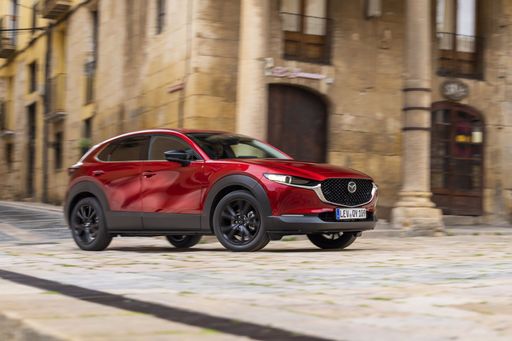 @ Mazda Motor Corporation
@ Mazda Motor Corporation
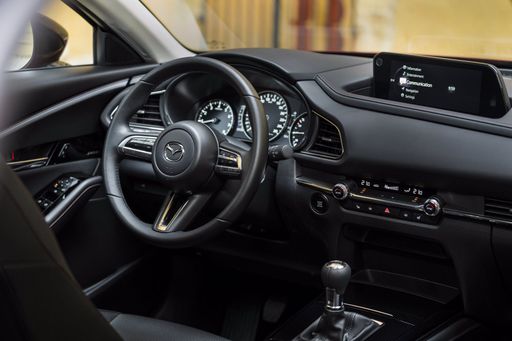 @ Mazda Motor Corporation
@ Mazda Motor Corporation
Suzuki Vitara
The Vitara is a city-smart SUV with a cheeky streak of off-road promise, perfect for drivers who want practicality without pretense. It’s honest, easy to live with and surprisingly likeable, a sensible companion for everyday adventures and weekend escapes.
details @ Suzuki Motor Corporation
@ Suzuki Motor Corporation
 @ Suzuki Motor Corporation
@ Suzuki Motor Corporation
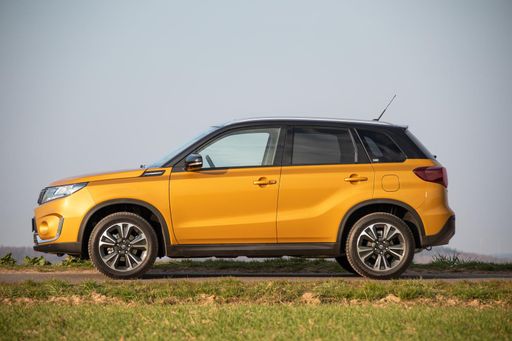 @ Suzuki Motor Corporation
@ Suzuki Motor Corporation
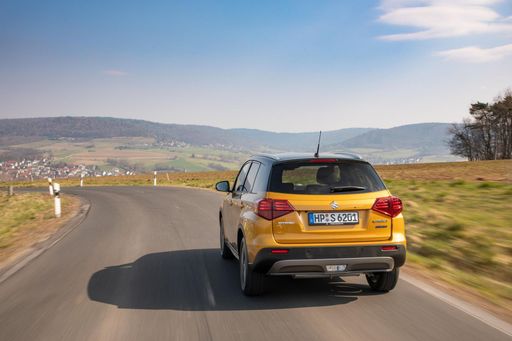 @ Suzuki Motor Corporation
@ Suzuki Motor Corporation
 @ Suzuki Motor Corporation
@ Suzuki Motor Corporation
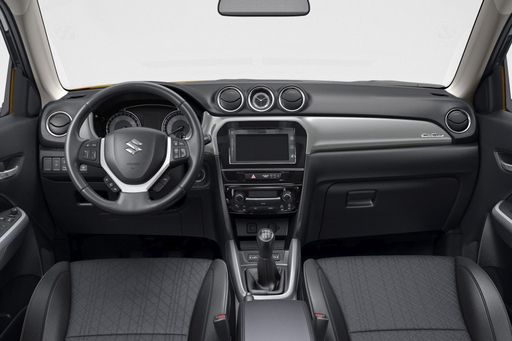 @ Suzuki Motor Corporation
@ Suzuki Motor Corporation
 @ Mazda Motor Corporation
@ Mazda Motor Corporation
|
 @ Suzuki Motor Corporation
@ Suzuki Motor Corporation
|
|
|
|
Costs and Consumption |
|
|---|---|
|
Price
25200 - 36800 £
|
Price
23600 - 30900 £
|
|
Consumption L/100km
5.7 - 6.6 L
|
Consumption L/100km
5 - 5.9 L
|
|
Consumption kWh/100km
-
|
Consumption kWh/100km
-
|
|
Electric Range
-
|
Electric Range
-
|
|
Battery Capacity
-
|
Battery Capacity
-
|
|
co2
129 - 148 g/km
|
co2
113 - 138 g/km
|
|
Fuel tank capacity
48 - 51 L
|
Fuel tank capacity
47 L
|
Dimensions and Body |
|
|---|---|
|
Body Type
SUV
|
Body Type
SUV
|
|
Seats
5
|
Seats
5
|
|
Doors
5
|
Doors
5
|
|
Curb weight
1455 - 1587 kg
|
Curb weight
1255 - 1395 kg
|
|
Trunk capacity
422 - 430 L
|
Trunk capacity
289 - 375 L
|
|
Length
4395 mm
|
Length
4185 mm
|
|
Width
1795 mm
|
Width
1775 mm
|
|
Height
1540 mm
|
Height
1595 mm
|
|
Max trunk capacity
1398 - 1406 L
|
Max trunk capacity
1046 - 1120 L
|
|
Payload
458 - 496 kg
|
Payload
375 - 400 kg
|
Engine and Performance |
|
|---|---|
|
Engine Type
Petrol MHEV
|
Engine Type
Petrol MHEV, Full Hybrid
|
|
Transmission
Manuel, Automatic
|
Transmission
Manuel, Automatic
|
|
Transmission Detail
Manual Gearbox, Automatic Gearbox
|
Transmission Detail
Manual Gearbox, Automated Manual, Automatic Gearbox
|
|
Drive Type
Front-Wheel Drive, All-Wheel Drive
|
Drive Type
Front-Wheel Drive, All-Wheel Drive
|
|
Power HP
140 - 186 HP
|
Power HP
110 - 129 HP
|
|
Acceleration 0-100km/h
8.3 - 10.3 s
|
Acceleration 0-100km/h
9.5 - 12.7 s
|
|
Max Speed
191 - 204 km/h
|
Max Speed
180 - 190 km/h
|
|
Torque
238 - 240 Nm
|
Torque
235 Nm
|
|
Number of Cylinders
4
|
Number of Cylinders
4
|
|
Power kW
103 - 137 kW
|
Power kW
81 - 95 kW
|
|
Engine capacity
1998 - 2488 cm3
|
Engine capacity
1373 - 1462 cm3
|
General |
|
|---|---|
|
Model Year
2025
|
Model Year
2024 - 2025
|
|
CO2 Efficiency Class
D, E
|
CO2 Efficiency Class
D, C, E
|
|
Brand
Mazda
|
Brand
Suzuki
|
What drive types are available for the Mazda CX-30?
The Mazda CX-30 is offered with Front-Wheel Drive or All-Wheel Drive.
The prices and data displayed are estimates based on German list prices and may vary by country. This information is not legally binding.
